CEDUNA
A VISITOR’S FISHING PARADISE
Steve Hunt describes why he, his mates and his family enjoy visiting one of the Far West Coast’s true gems.
Ceduna – a place I had driven past for over quarter of a century chasing big fish from the promised lands of Fowlers Bay and the legendary Yalata beaches. Previously it had been just a fuel stop over, a place to get a bite to eat, or a quick grocery shop.
But things have changed of late; first a stay in the local caravan park and then a full-on boy’s trip have opened my eyes to what is a wonderful fishery in its own right.
The name Ceduna is a local Aboriginal Wirangu word pronounced Chedoona, which roughly means a place to sit down and rest. And it certainly is that, nestled on the calm waters of Murat Bay, overlooking the town jetty from a shore lined with majestic Norfolk Island Pines. As the sea breeze starts to slow down and the blazing sun sinks slowly in the west, the views are to die for.
Situated some 775 kilometres from Adelaide, Ceduna is the gateway to the Nallarbor Plain, and is usually the last stop-over for travellers heading west. The town holds everything that the travelling fisherman should need – supermarket, chemist, fuel, bottle shop, pub and four caravan parks. The Foreshore Caravan Park is our favourite, and it is conveniently located next door the Foreshore Hotel Motel.
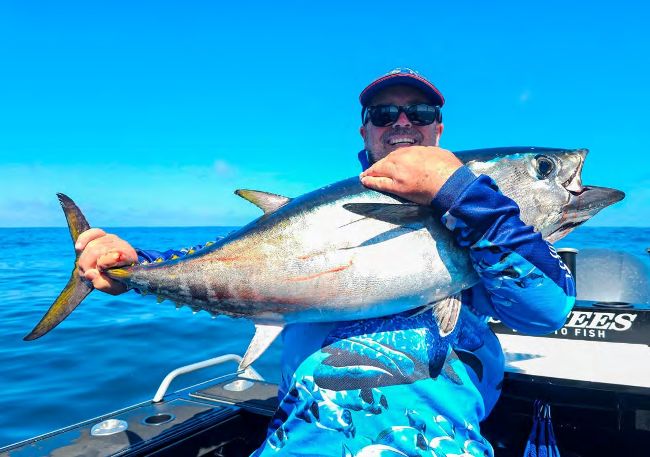
Tuna are nearly always a summer time option offshore
More importantly, however, for the trailerboat fisherman there is an excellent four-lane boat ramp just a couple of kilometres from town on the Thevenard Road. Boasting two pontoons, relatively deep water and plenty of boat parking spaces, it is a great facility. It pays to get there early to nab one of the 15 parking bays at the top of the ramp, or it will entail a bit of a walk to the main car park.
Once launched, stick to the well-marked channels inside the bay, as there are some very shallow areas and rocks that are exposed at low tide. There are two main channels, the first is the main shipping channel that starts at the thriving shipping port of Thevenard, heads out past St Peters Island and out to the open sea. The second guides you around the sand spits and bays south to Laura Bay.
As with much of South Australia, the number one target for the trailerboat fishermen fishing around Ceduna is the humble King George whiting. And rightly so; this succulent table fish is available in good numbers year-round, so much so that it gets invaded by the Mexican tinny brigade from south of the border every year. This annual migration takes place during the prolific autumn months.
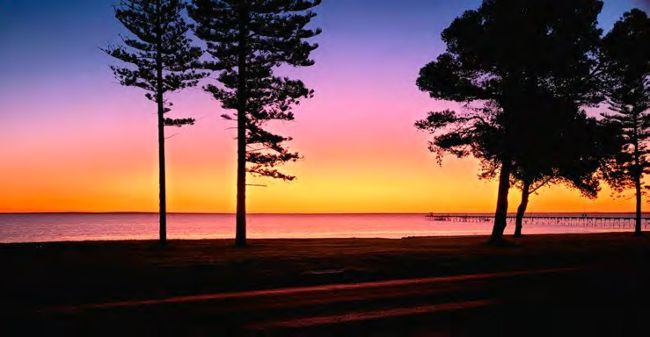
Ceduna foreshore sunset
I first experienced this champagne whiting fishing with local Andrew Wotton, who owns Andrew Wotton Marine and Ceduna Boat Hire. We had arrived at Andrew’s spot, half way to Smoky Bay right on the cusp of low tide, and once that water began to flood back in, the switch had been flicked onto one of the hottest whiting bites you could imagine. They were all great fish too, many above 40cm.
The next day Carolyn and I hired Ceduna Boat Hire’s 4.2m Quintrex Busta tinny and towed it to nearby Davenport Creek, where half the fun is just getting there. The last five kilometres are along the beach and up and over the sand dunes, so it is a 4wd proposition, along with the obligatory 18 psi tyre pressures. But once there, this idyllic little estuary is simply breath taking. Launching was a breeze, and after exploring this magnificent little waterway we headed out into the main body of water that encompasses Davenport Creek. Having never fished here before, we were a bit clueless as to locations, but quickly found some productive looking ground not far from the entrance. We anchored, then proceeded to catch our boat limit within two hours. That’s how easy it is.
On our most recent boys’ trip we fished from our own boats around Ceduna for a week and, along with several other fishy locations, we fished the waters of Davenport Creek three times. It is around 20 kilometres across the bay to Davenport Creek and it pays to stick in the shipping channel until you get close to the main channel into the creek. This area is shallow water whiting fishing at its finest.
Legal size for this part of the world is 30cm. They are not generally huge fish in here, most whiting averaging around 3236cm, but you will still get the odd fish of 40cm or more. Berley is an advantage, but it will also attract unwanted species like striped trumpeters in the warmer months. We also caught silver trevally, tommies, salmon trout and the odd flathead.
The open ocean is not far away at all, with Point Continentale just a kilometre away, which means anything could be possible within these waters. Indeed, good sized snapper have been caught within the creek in the past. And while fishing in 5m of water, the surface exploded with shards of small baitfish as a small ‘jelly bean’ tuna smashed through the surface in pursuit. And I hadn’t even had a beer!
And speaking of tuna, it had been a lean year in South Australia as a cold upwelling from the South East had kept most tuna out of reach of the average trailerboat fisherman. We were hoping for a late run to correspond with our stay, and mid-week our chance had come with perfect weather forecast. It would entail a long run out to Cannan Reef which lies over 80 kilometres offshore.
Cannan reef is a legendary big fish location, with samson fish, kingfish, big silver trevally, blue groper, XOS salmon and, of course, southern bluefin tuna waiting for you. It is a long haul, but there are the many islands of the Nuyts Archipelago to protect you from the south-east, which can also used as safe overnight anchorages if on an extended trip. With weather closing in, ours was only a day trip however,
On the way out several of the islands, including the magnificent St Francis Island, are classed as Sanctuary Zones with no fishing allowed, so remember to check your charts. Once we had passed Fenelon Island, the deep blue of the wild Southern Ocean opened in front of us, with the rugged granite outcrop of Cannan Reef still 10 kilometres further out to sea.
But it looked very promising indeed, as the water temperature slowly rose the further we headed south, and hundreds of hungry seabirds suddenly filled the horizon. There was one particularly frenzied bust up to our port side, so we introduced three minnow lures to the water and got the Surtees Gamefisher up to trolling speed. As we neared the carnage, big blue torpedoes began exploding through the surface.
It was my Rapala X Rap 15 Magnum in the dynamite Bonito pattern that got smashed first, and as I eased back the throttle on the Yamaha 200, the little Saltiga continued to scream. As I fought the fish, Doug, who had just stopped for a fuel top up from one of his jerry cans, had seen the action and they began readying their gear. After what seemed an eternity, the fish was netted and we were ready to go again.
As we trolled toward the nearby school, hoots of joy could be heard from Skinny and Doug in the other boat as two rods lunged forward in a double hookup. We too got the daily double soon afterwards when Garry’s Takumi and Rob’s X Rap got nailed by a couple of lit up bluefin tuna. It was cool watching the boys slug it out with nice tuna approaching 20 kilos, especially for Rob who was a newbie at this.
Both boats played around for a bit longer chasing the numerous schools in the near vicinity and everybody had a ball on this perfect day on the blue water – especially so because the tuna had been conspicuous by their absence on the normally productive grounds closer to Adelaide. But the lure of new ground and exciting species beckoned as we motored on toward Cannan Reef, still 7 kilometres away.
As we neared the wave-washed granite monolith that is Cannan Reef there was a series of dramatic drop offs that I was keen to explore. We dropped the lures back in the water then got up to trolling speed again, keeping an eye on the impressive bottom topography on the screen of the Garmin 8416 sounder. We had only been trolling for a couple of minutes before my Rapala got crunched again.
It was a blistering first run, followed by a series of brutal headshakes that had me thinking kingfish, especially with the wild territory we were trolling through. There was plenty of white water on the surface lingering around as the southern end of the reef took the brunt of the powerful Southern Ocean swells. After a very spirited fight it was, however, not a kingfish, but the biggest bluefin tuna of the day.
From there both boats motored around to the southern side of the reef to try our hand at bottom bouncing both with baits and lures. I was trying out the new Nomad Squidtrex soft vibe lures, which are so lifelike, they simply had to work out here. I had the Yamaha Helm Master EX in Fishpoint mode which basically keeps the boat hovering above your chosen patch of reef without the need to anchor.
Out of the corner of my eye I noticed that Skinny in the other boat was hooked up and losing line at an astonishing rate, as the fish headed for the jagged reef below. He ended up getting absolutely smoked by a leviathan of the deep as the taut braid caught the edge of the reef and let go in a brutal recoil. Skinny retreated to his tackle box, in the hope of round two.
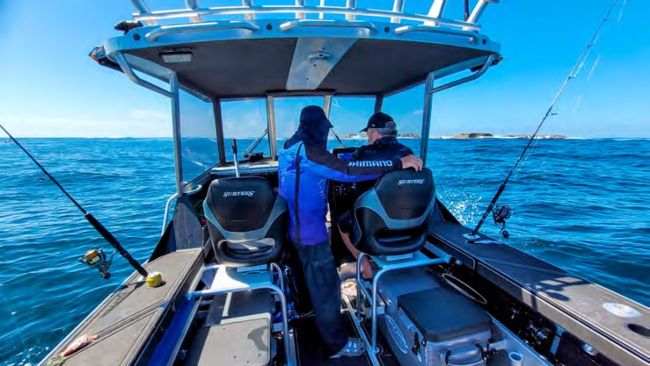
Cannan Reef is a long ride offshore
Meanwhile, the Squidtrex was attracting plenty of interest down below, with several swallowtail taking an interest, and a few small nannygai. But then it got thumped by something slightly larger that, once hooked up, began to bulldoze stubbornly along the reef top. It was a nice little blue groper that broke the surface, even though it still had its juvenile green colouration.
Doug, Skinny and Wally in the other boat had motored around to fish the huge wash area being produced by powerful Southern Ocean swells pounding into the southern end of the granite island. As is quite common with kingfish, a school of six or seven big fish screamed out after the skipping stickbait on the first cast, then peeled off at the last minute. And that was the last they saw of them.
We both settled into a couple of more hours’ bottom bouncing, with a variety of reef dwelling fish coming aboard and a very feisty bronze whaler shark that was released boatside. But we were keen for more tuna action and after covering the 6 kilometres to the north, birds began to appear and water began to explode again. It was a very enjoyable couple of hours battling electric blue torpedoes.
Another species that the Ceduna waters are famous for is the southern calamari, and they abound in the seagrass beds and out the front of the spectacular rocky shoreline in shallower water. These rugged, more remote spots hold some real thumpers just waiting in ambush to pounce on anything that moves. Introducing a few quality squid lures into the mix is like shooting fish in a barrel.
They would have never seen a squid jag before and eager to beat the competition, they showed no fear in chasing down that easy meal. When drifting from the boat we normally would have three jigs drifting out the back and a couple standing by on casting rods to explore more territory if things are quieter. However, usually around here the action is non stop on the drifting jigs unless, of course, the water is dirty.
One of my favourite jigs for shallower water is the Daiwa Emeraldas Nude 30 in the Mango Shrimp pattern. Squid simply love these colours with a green back with dark stripes, yellow sides, and an orange belly. Many brands have the same colour scheme, with Duo D Squid Mango Shrimp, Yo Zuri Aurie Q green and orange, and the Shimano Glow Banana Prawn all brilliant in waters 2-5m deep.
Southern calamari are the gift that keeps giving, be it a succulent sweet chilli calamari on the barbie, seared olive oil and lemon calamari over an open fire or many other sweet cooking options. Fresh squid candles are a dynamite bait for whiting, as are the other tentacles, and whole squid heads are deadly on the deep reef systems. The left-over guts, with all its oils, also make for a wonderful berley.
Another Ceduna seafood that also makes for a wonderful berley is the razorfish, which are available from the shallower areas throughout the bay. Only take enough for your immediate needs (75 per boat per day seems way too many) because they are a very vulnerable resource, that needs protecting. These large bivalves make a brilliant whiting bait and are mouthwatering on the table as well.
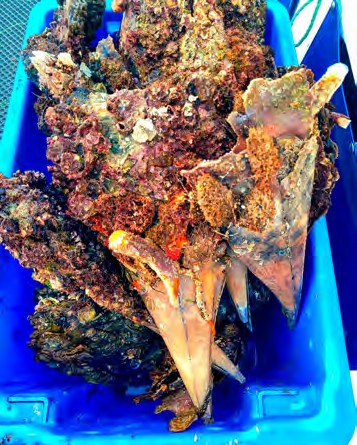
Razorfish make great bait, and dinner
Blue swimmer crabs appear in the warmer months, and there are so many areas to explore by boat across the expanses of Murat Bay for this succulent seafood, it never feels crowded. If you do not have your own boat, give Ceduna Boat Hire a call, as their 4.2m Quintrex Busta and 40hp Honda is perfectly suited to these waters. Ceduna jetty and nearby Denial Jetty are also hot spots for crabs.
The land-based fishing options around Ceduna are many and varied, with the two jetties being popular, especially during the school holidays, and the breadand-butter species are usually in good numbers. Nearby Davenport Creek is a wonderful little location for flathead on plastics, salmon trout, mullet, and King George whiting. You do need a 4wd to get here though, but it is an easy journey with tyres deflated.
There are numerous rock fishing spots around Ceduna, with good fishing platforms both to the east and west of the town. The usual culprits are generally in good numbers around these spots, including, salmon, snook, tommies, mullet, and garfish from the calmer locations with plenty of weed in close. This scenario also equates to good catches of squid in close.
The more open surf beaches to the west can offer some excellent salmon fishing when schools are in residence, but as with any other salmon locations, this can be a bit of a lucky dip. Salmon, being so mobile, can turn up anywhere anytime, so if exploring/ sightseeing, it always pays to have a couple of casting rods on hand, both for whole pilchards and metal baitfish profile lures.
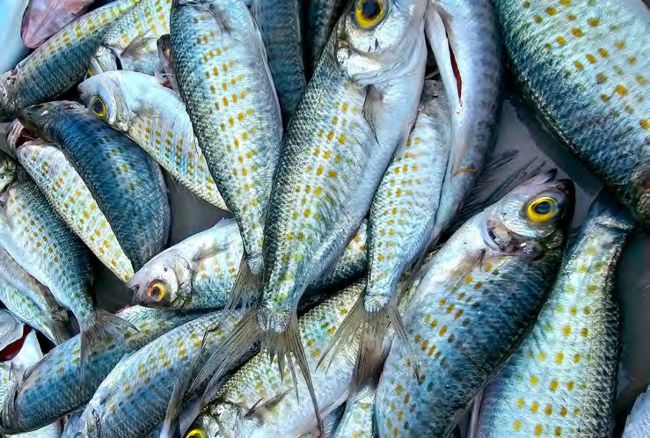
Both Thevenard and Ceduna jetties yield plenty of tommies
So that’s Ceduna in a nutshell. It’s a pretty cool place with excellent fishing, great boat ramp, many accommodation options and great meals at the pub. If you are boat fishing at Ceduna, there is one thing that we noticed – a sea breeze in the afternoon that blows up every day. It’s just one thing to keep in mind, but it really isn’t that bad, and it can actually be a blessing on a hot Ceduna afternoon.
Ceduna, it’s not just a fuel stop, but a fantastic fishing destination in its own right. See you there!